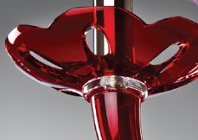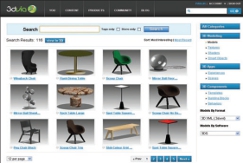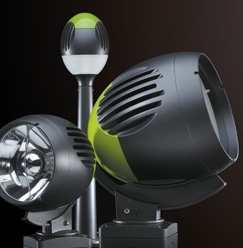Clear-cut beauty
Crystal specialist Preciosa has been crafting stunning chandeliers and light fixtures for over 60 years, producing the ideal focal point in many prestigious buildings around the world.
Based in the Liberec region of the Czech Republic the company works with a Bohemian tradition that dates back to 1724, although its methods of design and production are strictly 21st century.
After a customer approves the initial sketches, Preciosa engineers use Inventor to create 3D models. From these models, the company can generate 3D views for customers to review and approve designs, as well as create the technical documentation needed for production.
For a company that creates custom fixtures for cathedrals, music halls, hotels, and palaces across the world, being able to digitally prototype a product and send it out quickly for review is a huge benefit to its turnaround time.
“Modern chandeliers may have lots of intricate design elements, such as triangular glass parts arranged in a spiral,” notes Vladimir Kadlec, head of the engineering team. “It would take us a month to design
this type of chandelier in 2D. But with the 3D design capabilities in Inventor, it takes two weeks or less.”
“The 3D models we create in Inventor are digital prototypes that we can evaluate from every angle,” says Josef Oulehla, an engineer at Preciosa. “Inventor lets us test for interferences before we go to production. As a result, we can eliminate mistakes and save money.”
By allowing designers to assess the appearance of light through the crystal and reduce the amount of physical prototypes, it has helped cut design time by 50 per cent. When it comes to production, having an accurate model to work to has helped cut manufacturing mistakes by 70 per cent.
In addition, using a 3D model allows Preciosa to meet critical weight requirements given to them by architects. “We must take into account the material and weight-bearing capacity of the ceiling,” explains Kadlec.
“Using Inventor, we can very precisely calculate the weight of a chandelier so that we know it will never fall down.”
www.preciosa.com
Virtually lit up
Taking shopping online might work for music, film and other media, but for some items you need a better sense of perspective – you need to be touchy-feely.
Getting your hands on something, or just being able to judge whether it’s going to fit into your home décor, is a big part of shopping and something some designers are tackling head on.
Internationally renowned industrial designer Tom Dixon has been at the forefront of furniture and interior furnishings design since the mid-1990s. Right now this UK-based designer is leading the way with how far 3D furniture and lighting designers can take their products.
His ‘Virtual Milan’ is a virtual interactive environment that enabled online viewers from anywhere in the world to experience his design studio’s stand at the Superstudio Piu design space, which was held during the Milan Furniture Fair during April 2010.
By navigating an avatar of their choice, viewers are able to explore all the elements of the stand as if they were actually at the exhibition, viewing Tom Dixon lighting products in real-life scale and colour in a lifelike 3D environment without travelling to Milan.
The same 3D models, designed in SolidWorks and transferred into Dassault Systèmes 3Dvia community platform, can also be viewed on an iPhone with the 3Dvia mobile app. The consumer can easily place the models into real life photos of their interiors to see how they would fit into their home décor.
The result is not only an expansion of the Tom Dixon brand on a global scale, but also a higher level of customer satisfaction.
The days of buying a new light fixture only to find that once home it is too big/small/clashes with your mohair rug and lava lamp are over.
www.tomdixon.net
Under ground, over ground
In-ground exterior lamps are not typically beautiful objects, but with some tight engineering and a slick aesthetic they could be deemed pretty enough for over-ground use.
As a result UK-based Paviom set itself a brief to offer new products with an environmental edge and, with the assistance of designer Jason Thawley, has created the distinctive Lofoot family of exterior lights.
A chance encounter in an ex-Ministry of Defence scrap yard with some Hawker Hunter jet plane navigation lights gave some inspiration to the shape of the light units.
As Thawley says, “These lights had been designed without compromise, to travel through the sound barrier, be subject to extremely fast changes in pressure and temperature yet work faultlessly.
“The design was simple, well thought through, extremely well engineered and manufactured.” The Lofoot lamps were sketched out to be modular units, helping to cut down on the amount of seals and bezels needed, before being drawn up in AutoCAD and transferred into Autodesk Inventor.
Tackling the problems of needing to be watertight, but allowing no condensation to be trapped within, the modular design meant they could be unplugged from their fixings and repaired in a controlled climate, without the need for numerous expensive parts.
This also led to the ‘bulb-like’ aesthetic that proved so likeable that it has been commissioned into a variety of projection and post-top variants, all with the casing out on show, giving Paviom a full family of products from a single design brief.
The 3D models were put to further use with the models being transferred into Autodesk 3ds Max to provide all the marketing images and potential variants to the client’s individual requirements.
The final products were built from high-quality aluminium to last 60 years. Using sustainable materials ensures that this range of energy efficient lighting is 90 per cent recyclable at the end of its life.
From under ground these lights might not see as much of the world as the Hawker Hunters, but through solid design they should easily last as long.
www.paviom.com

3D technology illuminates lighting design and manufacture










